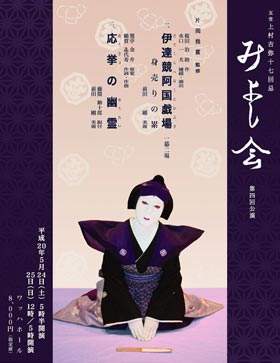| MAY 2008 |
|
4 shows in T˘ky˘ (Kabukiza, Shinbashi Enbuj˘), 2 in ďsaka (Sh˘chikuza, Wahha Kamigata Engei Hall) and 1 in Ky˘to (Minamiza)!
|
| Kabukiza (T˘ky˘) |  |
| Dates | 2 ~ 26 May 2008 (Dankikusai Gogatsu ďkabuki) |
| MatinÚe |
|
| Evening |
Shikakubashira Saru no Kusemai |
| Casting |
Ichikawa Danjűr˘, Onoe Kikugor˘, Sakata T˘jűr˘, Nakamura Tomijűr˘, Band˘ Mitsugor˘, Nakamura Tokiz˘, Nakamura Baigyoku, Ichikawa Ebiz˘, Ichikawa Sadanji, Nakamura Kaishun, Onoe Sh˘roku, Ichikawa Danz˘, Nakamura T˘z˘, ďtani Tomoemon, Kawarasaki Gonjűr˘, Band˘ Hikosabur˘ |
| Comments |
|
| Shinbashi Enbuj˘ (T˘ky˘) |
| Dates | 2 ~ 26 May 2008 (Gogatsu ďkabuki) |
| MatinÚe | |
| Evening | |
| Casting |
Nakamura Kichiemon, Nakamura Shibajaku, Ichikawa Danshir˘, Ichikawa Kamejir˘, Nakamura Fukusuke, Ichikawa Somegor˘, Nakamura Kinnosuke, Nakamura Kash˘, Nakamura Karoku |
| Comments |
Nakamura Kichiemon is for the third time the zagashira of a troupe of young actors performing at the Shinbashi Enbuj˘. He plays the roles of Komagata M˘hei and Tamiya Iemon in the dramas "Ippon Gatana Dohy˘ Iri" and "T˘kaid˘ Yotsuya Kaidan".
|
| Sh˘chikuza (ďsaka) |
| Dates | 4 ~ 27 May 2008 (Super Kabuki) |
| Program | Yamato Takeru |
| Casting |
Ichikawa Ukon, Ichikawa Danjir˘, Ichikawa Emiya, Ichikawa Monnosuke, Ichikawa Emisabur˘, Ichikawa Shun'en, Ichikawa En'ya, Ichikawa Juen, Kaneda Ryűnosuke |
| Comments |
Ichikawa Ennosuke's troupe of young and talented actors perform a modern style of theater, which they created a few years ago and called "Super Kabuki" (SűpÔ Kabuki in Chikamatsu Monzaemon's lingo): it's spectacular (lots of chűnori), the costums are gorgeous and ultra-sophisticated, the music is modern, the texts are easy to understand and the plots are as twisted as a good Kabuki classic. Usually a big commercial success! "Yamato Takeru" was the first SűpÔ Kabuki drama of the Omodakaya guild and the most successful one. For this revival, the leading role of Yamato Takeru is played by both Ichikawa Danjir˘ and Ichikawa Ukon. Ichikawa Ennosuke is on sick leave and does not perform in this production. |
| Wahha Kamigata Engei Hall (ďsaka) | |
| Dates | 24 ~ 25 May 2008 (Miyoshi no Kai) |
| Program |
Date Kurabe Okuni Kabuki (Miuri no Kasane) ďkyo no Yűrei |
| Casting | |
| Comments |
Fourth edition of the program of the association Miyoshi no Kai, which stars the young and talented actor Kamimura Kichiya. |
 |
|
|
|||
| Dates | 27 ~ 28 May 2008 (Sanky˘kai) | ||
| MatinÚe |
Chikubushima Tsukimi Zat˘ Adachi-ga-Hara |
||
| Evening |
Gonin Sanbas˘ Adachi-ga-Hara |
||
| Casting |
Ichikawa Kamejir˘, Kataoka Takatar˘, Ichikawa Somegor˘, Nakamura Baishi, Nakamura Kazutar˘ |
||
| Comments |
Special program of the Sanky˘kai, an experimental group led by three musicians: Kamei Hirotada, Tanaka Denzaemon XIII and Tanaka Denjir˘ VII. The programs of the Sanky˘kai mixes actors and musicians from the Kabuki, N˘ and Ky˘gen world. |
||
|
|
| Contact | Main | Top | Updates | Actors | Plays | Playwrights | Programs | Links | FAQ | Glossary | Chronology | Illustrations | Prints | Characters | Derivatives | Theaters | Coming soon | News |